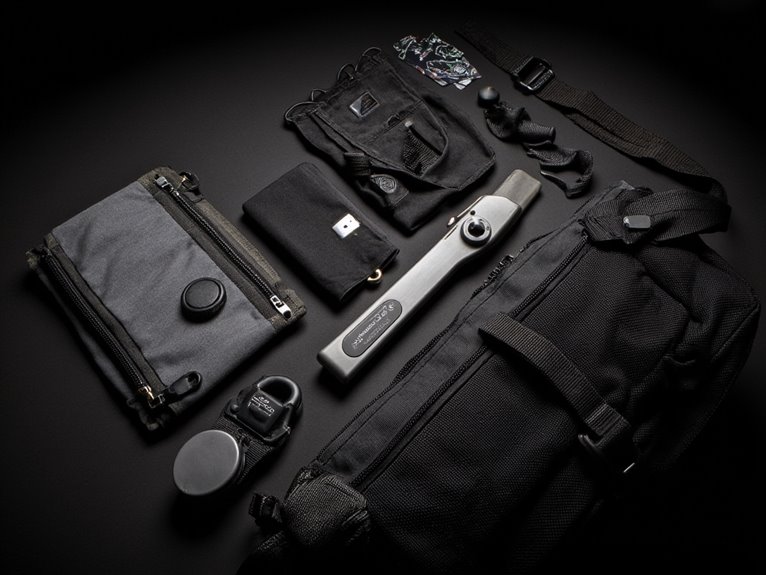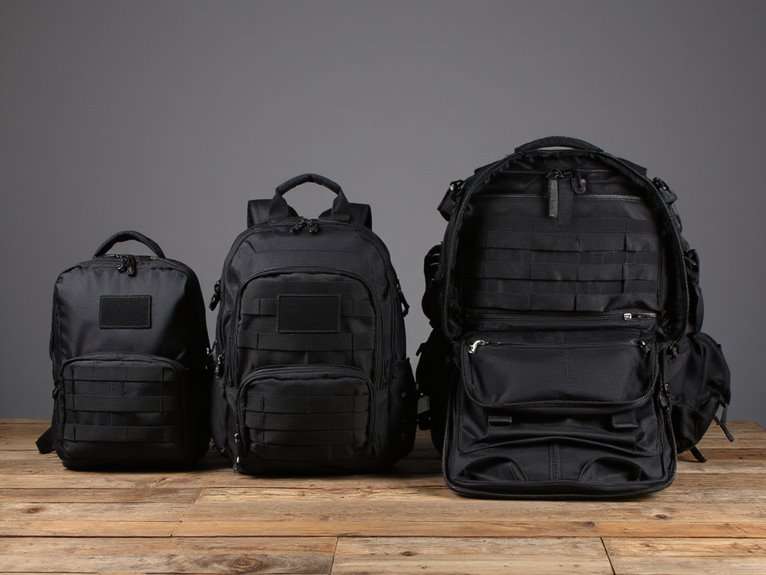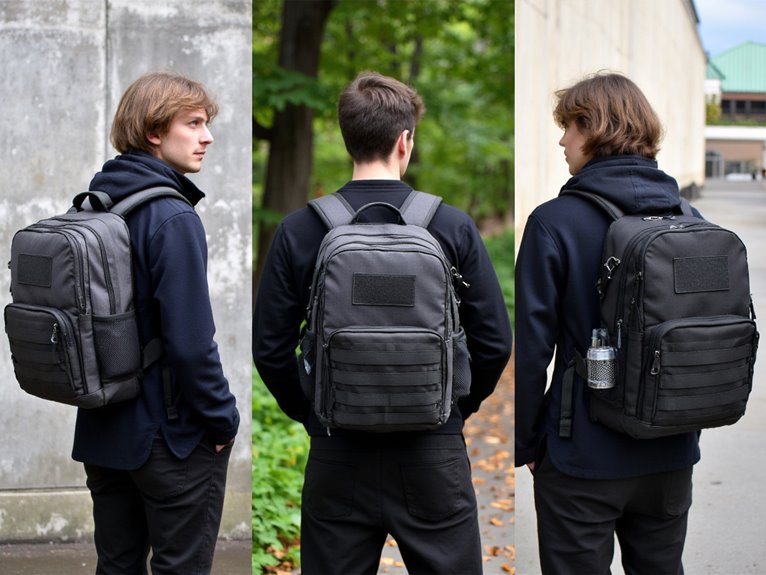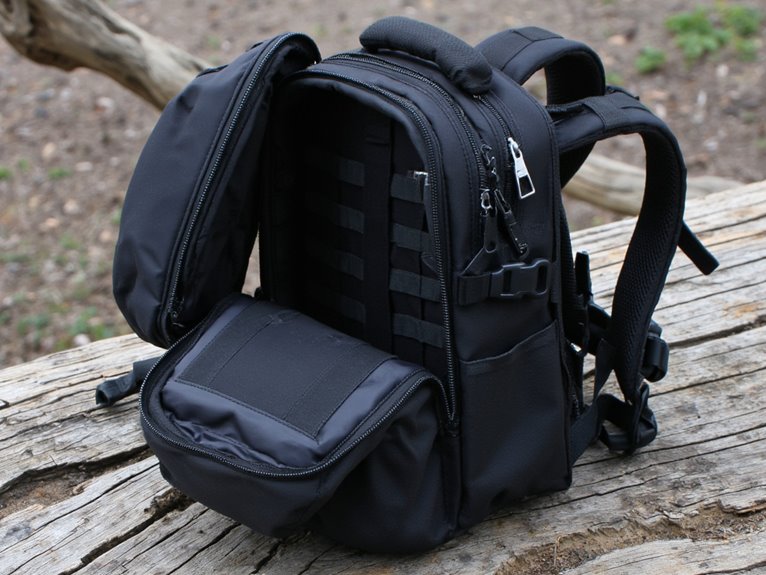Essential Features to Look for in Concealed Carry Backpacks
You’ll need a concealed carry backpack with discreet aesthetics that resembles standard bags, featuring lockable zippers and RFID-blocking pockets for security. Look for anti-slash materials like high-density nylon with water-resistant coatings for durability. Quick-access compartments with emergency draw mechanisms guarantee fast firearm retrieval, while padded shoulder straps and load distribution systems provide ergonomic comfort during extended wear. Multi-pocket storage solutions and MOLLE webbing compatibility accommodate holsters and tactical accessories effectively. Understanding these specifications will help you identify the most suitable options for your specific requirements.
We are supported by our audience. When you purchase through links on our site, we may earn an affiliate commission, at no extra cost for you. Learn more. Last update on 5th January 2026 / Images from Amazon Product Advertising API.
Notable Insights
- Look for discreet designs with standard silhouettes, neutral colors, and minimal tactical features to avoid drawing attention.
- Prioritize quick access systems with emergency draw mechanisms and dual-access compartments for fast firearm retrieval when needed.
- Choose anti-slash materials like high-density nylon with lockable zippers and RFID-blocking pockets for enhanced security protection.
- Ensure ergonomic comfort features including padded shoulder straps, load distribution systems, and adjustable hip belts for extended carry.
- Select backpacks with dedicated concealed compartments, protective foam padding, and retention mechanisms specifically designed for firearms.
Discreet Design Elements That Maintain a Low Profile
When choosing a concealed carry backpack, the design’s ability to blend seamlessly with everyday bags determines its effectiveness.
Stealth aesthetics rely on standard silhouettes that mimic typical school or work backpacks. You’ll want clam-shell or zipper access systems that look identical to conventional closures.
The most effective concealed carry backpacks are indistinguishable from ordinary bags through conventional design elements and standard closure systems.
Concealed compartments should integrate into flat laptop sleeves or rear panels without creating obvious bulges.
Successful designs maintain 15-22 liter capacities with slim profiles. Neutral colors like black or earth tones won’t draw attention.
External features must stay minimalistic-avoid tactical webbing or oversized pouches that scream “tactical gear.”
The best backpacks use rounded edges and smooth fabrics. Look for models with crossbody compatible straps that provide multiple carrying options without compromising the bag’s civilian appearance.
Side access panels should position discreetly, while internal organization prevents noticeable shape distortion that could reveal contents. Specialized compartments help maintain organization while keeping ammunition and accessories properly secured.
Premium Materials and Anti-Theft Security Features

A low-profile appearance means nothing if your backpack can’t withstand daily abuse or protect against theft attempts.
You’ll need premium materials that balance protection with practicality.
Synthetic advantages include lightweight construction and anti-slash technology that resists cutting attacks. These fabrics cost less while delivering superior theft protection. High-density nylon and ripstop materials offer exceptional tear resistance for heavy-duty applications.
Leather durability provides long-term value despite requiring regular maintenance. Canvas delivers water resistance with casual aesthetics suitable for everyday carry.
Essential security features include lockable zippers, RFID-blocking pockets, and hidden compartments.
Slash-resistant layers deter bag cutting attempts. Biometric locks offer advanced access control while maintaining TSA compliance. Water-resistant coatings protect internal contents from environmental damage. Reinforced bottoms provide crucial protection in high-wear areas where the backpack contacts surfaces most frequently. Look for bags with padded straps and ergonomic designs to ensure comfortable weight distribution during extended carry periods.
Ergonomic Comfort for Extended Daily Wear
Since extended daily carry can strain your body over hours of wear, proper ergonomic design becomes critical for maintaining comfort and preventing fatigue.
Extended daily carry demands thoughtful ergonomic design to prevent body strain and maintain all-day comfort during regular use.
Quality concealed carry backpacks incorporate sophisticated load distribution systems that transfer weight from your shoulders to your hips, reducing upper body strain greatly.
Essential comfort features include:
- Padded shoulder straps with breathable mesh covering and contoured design following natural shoulder curves
- Adjustable hip belts that shift weight to your skeletal structure instead of soft tissues
- Ventilated back panels with moisture-wicking materials and spine-contoured padding for proper posture
- Sternum straps that connect across your chest for stability and prevent shoulder strap slippage
- Lightweight construction using ergonomic shaping that matches natural body contours without restricting movement
These engineered systems work together to minimize pressure points and distribute loads evenly across your torso.
Much like portable projectors that prioritize weight distribution for extended use, concealed carry backpacks must balance functionality with comfortable carrying capacity throughout long days.
Quick Access Systems and Organizational Compartments
When you’re carrying concealed, you’ll need lightning-fast access to your weapon during emergencies-some quick access systems enable draws in under two seconds.
Your backpack’s emergency draw mechanisms should feature specialized deployment straps and dual-access compartments that work with your natural movement patterns, not against them.
Beyond weapon access, you’ll require organized storage that separates your firearm from everyday items through dedicated compartments for magazines, electronics, and medical supplies.
Look for retention mechanisms that securely hold your firearm yet allow for quick retrieval, similar to those found in quality holster designs.
Emergency Draw Mechanisms
Emergency draw mechanisms represent the most critical engineering challenge in concealed carry backpack design, where milliseconds can determine the difference between successful defensive action and catastrophic delay.
Your backpack’s draw speed in emergency scenarios depends on these specialized features:
- Flex cuff channels that secure firearms vertically, preventing movement during transport
- Drop pocket mechanisms with low-profile access points for immediate firearm retrieval
- Dual-access zipper systems accessible from multiple angles without full bag removal
- Quick-release buckles and magnetic closures that alleviate fumbling under stress
- Dedicated holster compartments with trigger guard protection for safe rapid extraction
These mechanisms work together to enable drawing without removing the entire backpack.
Heavy-duty zippers with extended pull tabs guarantee smooth operation under pressure, while retention features prevent accidental drops during quick extraction.
Multi-Pocket Storage Solutions
Beyond rapid firearm access, your concealed carry backpack‘s effectiveness depends heavily on how well its multi-pocket storage solutions organize and secure your gear.
Multiple compartments enable superior item segmentation, allowing you to separate firearms, ammunition, electronics, and personal items efficiently. Dedicated internal organizer panels feature mesh pockets that enhance visibility of small accessories like spare batteries or medical supplies.
External zippered pockets provide additional storage for everyday items that don’t require concealment. Padded laptop sleeves protect electronics while maintaining organization.
Modular hook-and-loop panels inside accept customized holsters and magazine carriers, greatly improving backpack accessibility. Special zippered pockets safeguard eyewear, while internal compartments accommodate body armor inserts.
This systematic approach guarantees every essential item has a designated, secure location for maximum preparedness and efficiency.
Optimal Size and Storage Capacity Considerations

How do you determine the right size for a concealed carry backpack that balances discretion with practical storage needs?
Your size specifications should match both daily carry needs and concealment requirements.
Most practical concealed carry backpacks fall between 30L to 40L capacity. This range provides adequate storage without excessive bulk that compromises discretion.
For airline travel, aim for dimensions around 22 x 14 x 9 inches (approximately 40L) to meet carry-on requirements.
Key size considerations include:
- 30L-40L capacity balances storage with discretion
- Airline-compliant dimensions: 22 x 14 x 9 inches maximum
- Slim profile prevents printing under clothing
- Multiple compartments separate firearm from everyday items
- Reinforced padding maintains shape and firearm security
Smaller 35L options work better for strict airline policies or minimalist users requiring under-seat storage compliance.
Quality concealed carry backpacks should incorporate protective foam padding similar to those found in premium rifle cases to ensure your firearm remains secure and undamaged during transport.
Style Versatility for Different Environments

After selecting the appropriate size, your concealed carry backpack’s style must adapt seamlessly across multiple environments without compromising discretion. Your backpack’s functionality aesthetics determine success in professional settings, casual outings, and tactical situations. Urban camouflage isn’t about military patterns-it’s achieving invisibility through design choices that mirror civilian expectations.
| Environment | Ideal Materials | Color Recommendations | Key Features |
|---|---|---|---|
| Professional | Leather, premium synthetics | Black, navy, charcoal | Sleek lines, minimal hardware |
| Casual/Social | Canvas, water-resistant nylon | Gray, olive, neutral tones | Convertible designs, subtle patterns |
| Outdoor/Tactical | Cordura, anti-slash fabrics | Earth tones, muted colors | MOLLE compatibility, reinforced construction |
| Urban Transit | Lightweight synthetics | Black, gray variants | TSA-friendly compartments, low-profile zippers |
Neutral colors provide maximum versatility while tonal designs eliminate unwanted attention. Convertible models shift from backpack to briefcase, expanding environmental compatibility without sacrificing concealed carry functionality. Unlike messenger bags that may draw attention in certain settings, backpacks offer universal acceptance across diverse social and professional environments.
Compatibility With Holsters and Tactical Accessories
Your concealed carry backpack’s effectiveness depends heavily on its compatibility with holster retention systems and tactical accessories.
Quality backpacks feature integrated MOLLE webbing that accepts standardized tactical gear while providing secure mounting points for modular holster configurations.
These attachment systems must maintain weapon security during movement while ensuring rapid access when needed.
Holster Retention Systems
When selecting a concealed carry backpack, the holster retention system serves as the critical bridge between weapon security and rapid accessibility.
Understanding retention system types guarantees you’ll choose compatible equipment that maintains firearm security during daily activities while enabling quick deployment when needed.
Active retention mechanisms incorporate thumb breaks, straps, or locking devices that must be disengaged before drawing.
These systems provide enhanced security but require additional training for smooth operation.
Consider these essential retention features:
- Friction retention uses molded pressure points around the trigger guard for secure weapon hold.
- Level I retention combines friction with clothing and belt support for concealed carry applications.
- Quick-release mechanisms balance security with rapid access for self-defense situations.
- Adjustable tension accommodates tactical accessories like lights or red dot sights.
- Firm mounting compatibility ensures holsters attach securely to backpack compartments without shifting.
MOLLE Attachment Points
Three key advantages make MOLLE (Modular Lightweight Load-carrying Equipment) attachment points essential for concealed carry backpacks: customizable holster positioning, scalable accessory integration, and mission-specific gear configuration.
You’ll find MOLLE customization options enable precise holster placement through woven strap threading and snapping mechanisms. This system lets you reposition holsters for ideal concealment while maintaining quick access based on your body type and carry method. The webbing accommodates various MOLLE-compatible holsters designed specifically for concealed carry applications.
Tactical accessories compatibility extends beyond holsters to include magazine pouches, medical kits, flashlight holders, and hydration systems. You can adapt your setup for different missions by adding or removing modular components.
Quality MOLLE webbing features reinforced stitching and web-reinforced nylon construction to handle heavy loads during dynamic movement and high-stress scenarios.
On a final note
You’ve now examined the critical specifications for concealed carry backpacks. Your selection must balance discrete appearance with rapid access capabilities. Don’t compromise on construction quality-premium materials guarantee long-term reliability. Test the quick-access system before purchase to verify smooth operation under stress. Consider your daily environment when evaluating style options. Remember that proper fit affects both comfort and concealment effectiveness. Choose based on your specific tactical requirements, not marketing claims.

